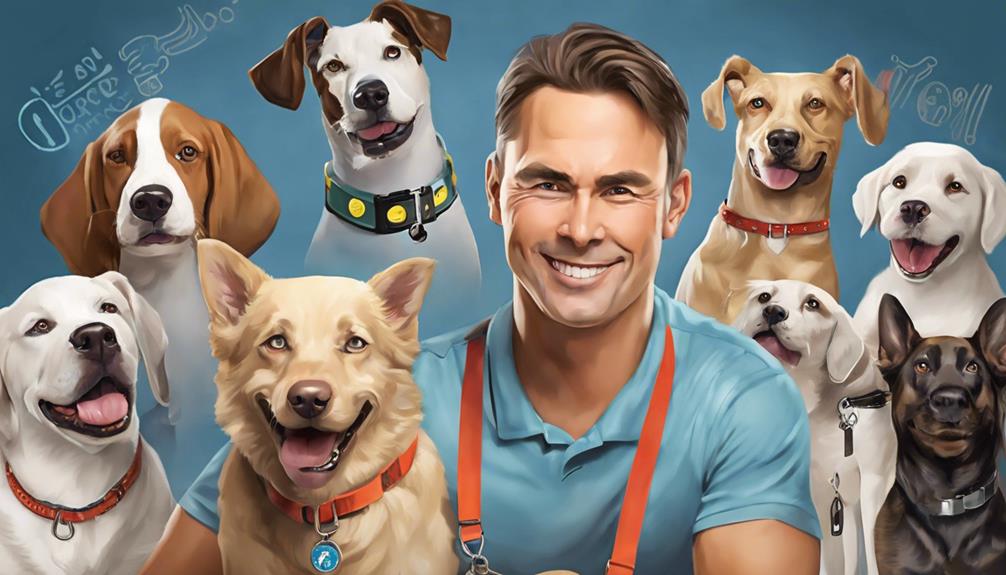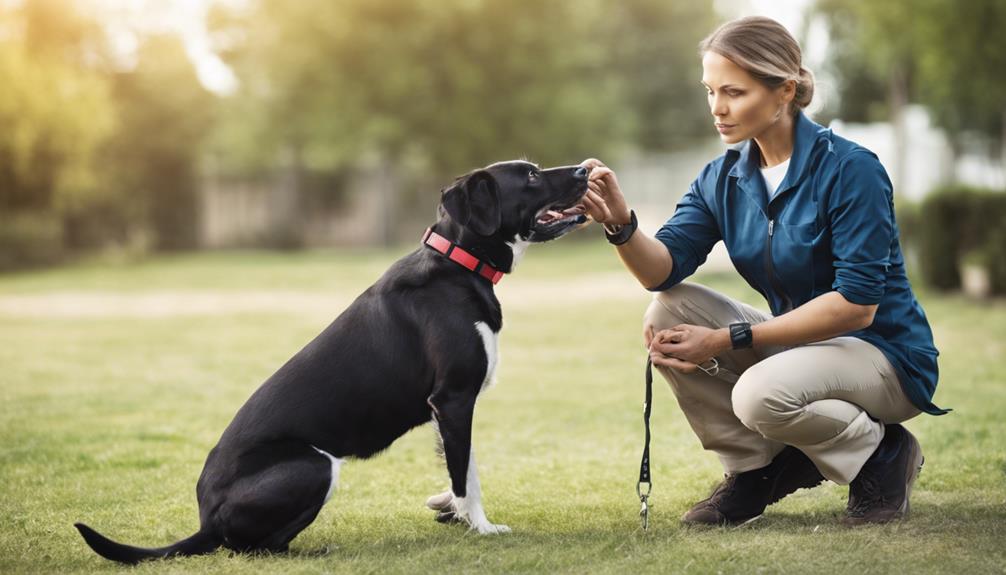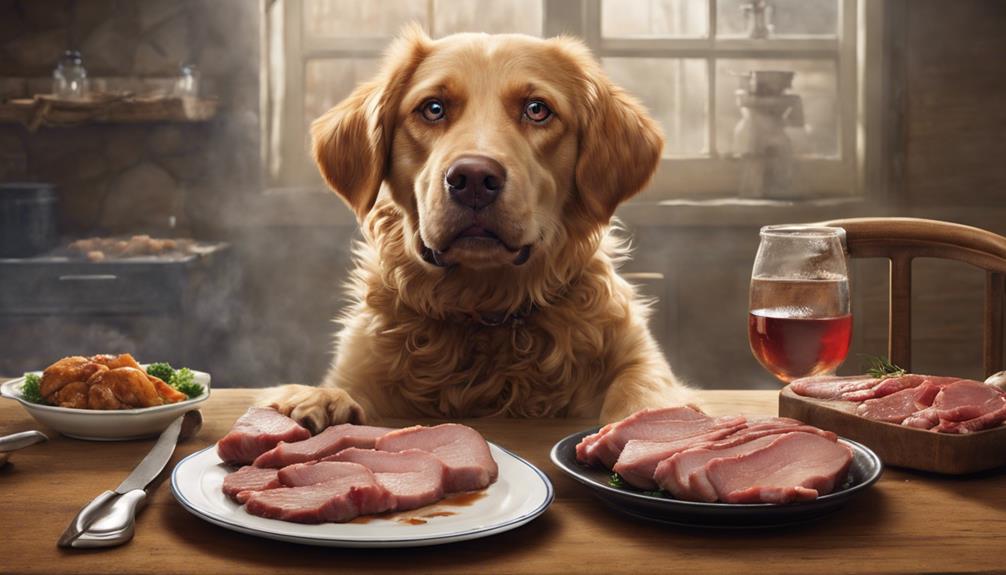To excel in dog training with training collars, it is crucial to understand the proper techniques and benefits while also being mindful of any misconceptions. Ensure that the collar fits correctly and utilize consistent reinforcement methods for clear communication. Begin with low stimulation levels and combine collar training with positive reinforcement to establish a positive learning environment for your beloved pet. Keep in mind that training collars serve as tools for communication and reinforcement, so make sure they fit securely and comfortably. Adjust intensity levels slowly to effectively reinforce desired behaviors.
By understanding these key concepts, you can establish a strong bond and clear expectations with your dog.
Key Takeaways
- Ensure proper collar fit for comfort and effectiveness.
- Pair collar training with positive reinforcement for best results.
- Gradually increase stimulation levels to reinforce desired behaviors.
- Seek professional guidance for tailored training plans.
- Monitor dog's response and adjust training based on individual needs.
Benefits of Using Training Collars
Using training collars can greatly enhance your dog's obedience and behavior. A dog training collar serves as a valuable communication tool, allowing for positive reinforcement of commands even from a distance.
By providing consistent corrections, these collars help prevent unwanted behaviors effectively. When used correctly, training collars play an essential role in improving your dog's recall and responsiveness, strengthening the bond between you and your furry companion.
They enable you to communicate clearly with your dog, reinforcing good behavior and discouraging negative actions. Through the use of training collars, you can establish boundaries and expectations for your dog, leading to a well-behaved and disciplined pet.
Remember, positive reinforcement is key when using a training collar, as it helps your dog understand what's expected of them and encourages them to follow commands willingly.
Embrace the benefits of using a dog training collar to enhance your training sessions and deepen your relationship with your canine companion.
Proper Techniques for Collar Training

When training your dog with a collar, it's vital to confirm the collar fits properly to prevent any discomfort during training sessions.
Consistent reinforcement methods will help your dog understand the desired behaviors more effectively.
Collar Fit Importance
Properly fitting the collar on your dog is vital for effective communication and successful training sessions. A well-fitted collar ensures comfort and prevents any irritation during training. By delivering consistent and accurate signals, a properly fitted collar helps reinforce commands from a distance. Incorrectly fitted collars can lead to inconsistent stimulation levels, which can impede training progress. Regularly checking and adjusting the collar fit is essential to guarantee your dog's comfort and safety during training exercises. Below is a table highlighting the importance of collar fit in dog training:
| Importance of Collar Fit in Training |
|---|
| Ensures effective communication |
| Prevents discomfort and irritation |
| Aids in delivering consistent signals |
| Promotes comfort and safety |
Consistent Reinforcement Methods
To effectively reinforce your dog's training, it's crucial to employ consistent methods of reinforcement, particularly through proper techniques with training collars.
When using e-collars, make sure the collar receiver fits snugly and comfortably on your dog. Start with low stimulation levels and gradually increase complexity to reinforce commands effectively.
Combine collar training with positive reinforcement to encourage desired behaviors. Remember, e-collars are intended as aids for positive training, not as punishment.
Consistency is key in using these tools correctly. By following these guidelines, you can help your dog develop a strong understanding of commands and behaviors, leading to successful training outcomes.
Common Misconceptions About Training Collars
Misconceptions about training collars can arise from misunderstanding their functions.
It's important to be aware that misusing these collars can have a negative impact on your dog's perception of training.
Proper collar usage involves education and training to guarantee the well-being of your pet.
Misunderstanding Collar Functions
Often misunderstood, training collars serve as tools to strengthen commands and prevent unwanted behaviors rather than as shortcuts for basic training. To clarify further, it's important to grasp that mishandling of these collars can lead to negative associations, hindering progress. Always start with low stimulation levels and combine the collar with positive reinforcement for effective and compassionate training. Ensuring the collar fits properly is essential for your dog's comfort, and gradually increasing the complexity of commands is key. Remember, training collars are not universally suitable, and seeking guidance from professional trainers can help determine if they are appropriate for your pet. Below is a table summarizing key points about training collars:
| Key Points | Details | Importance |
|---|---|---|
| Strengthen Commands | Prevent unwanted behaviors | Effective Training |
| Positive Associations | Pair collar with positive reinforcement | Ethical Training |
| Misuse Prevention | Start with low stimulation levels | Avoid Negative Associations |
| Consult Professionals | Ensure collar fits properly | Determine Suitability for Your Pet |
Negative Impact Perception
Training collars, despite their misunderstood reputation, can be valuable tools for reinforcing positive behaviors when used correctly. It's important to debunk common misconceptions surrounding these tools, such as the belief that they're shortcuts for training or a substitute for basic obedience training.
Misuse of shock collars can lead to negative impacts on your dog's well-being, emphasizing the need to guarantee proper education on training techniques. Remember, training collars shouldn't replace dog basic obedience training.
Each dog has unique needs, so it's vital to take into account individual temperament before incorporating training collars. Seeking guidance from professional trainers and using these tools responsibly can help address misconceptions and make sure a positive training experience for both you and your furry companion.
Proper Collar Usage
To guarantee successful communication and reinforcement in dog training, it's crucial to grasp the correct usage of training collars and dispel any misunderstandings surrounding their application.
When it comes to training collars, here are some key points to take into account:
- Training collars shouldn't be seen as a shortcut but as a tool for communication and reinforcement.
- Pairing training collars with positive reinforcement leads to a positive learning experience.
- Misusing training collars can create negative associations, highlighting the need for responsible usage and proper education.
- Properly adjust collars for a comfortable fit to prevent discomfort during training.
- Gradually increasing command complexity with training collars can effectively reinforce desired behaviors.
Mastering these aspects will help you achieve the best results in your dog training endeavors.
Training Success Stories With Collars

Using training collars has resulted in remarkable success stories where dog owners have seen significant improvements in their pets' behavior and responsiveness. Owners have reported improved recall and responsiveness in their dogs after using training collars. These collars have enhanced behavior in challenging environments, leading to better control and obedience. Many owners have experienced strengthened bonds with their dogs through consistent training with collars. Collars have helped increase confidence in both the dog and the owner during training sessions. Training collars have been effective in improving overall behavior and communication between owners and dogs.
| Success Stories With Training Collars | Benefits |
|---|---|
| Improved recall and responsiveness | Better control and obedience |
| Strengthened bonds between owners and dogs | Increased confidence during training sessions |
| Enhanced behavior in challenging environments | Improved overall behavior and communication |
These success stories highlight the positive impact of using training collars in dog training, showing how they can reinforce good behavior and improve training sessions.
Ethical Considerations in Collar Training

Considering your dog's well-being and comfort is paramount when incorporating collar training techniques. When using training collars, it's crucial to uphold ethical considerations to guarantee a positive training experience for both you and your furry companion. Here are five key points to keep in mind:
- Prioritize your dog's comfort: Always make sure that the collar fits properly and doesn't cause any discomfort.
- Avoid overstimulation: Be mindful of the intensity and duration of the stimulation to prevent distress.
- Monitor for signs of discomfort: Regularly check your dog for any signs of irritation or stress while using the collar.
- Seek professional guidance: If you have any concerns or questions about using training collars, consult with professional trainers for assistance.
- Tailor training to your dog: Respect and consider your individual dog's temperament and specific needs when implementing collar training methods.
Tailoring Collar Training to Dogs

Tailoring collar training to suit individual dogs' needs enhances the effectiveness of training methods and fosters better communication between you and your canine companion.
To teach your dog effectively, it's important to tailor the training to your dog's temperament. Different dogs respond differently to training methods, so understanding your dog's temperament is key. Reinforcing desired behaviors through collar training requires adjusting the intensity levels based on what works best for your dog.
By customizing the training to cater to your dog's temperament, you guarantee that the training isn't only effective but also safe and comfortable for your furry friend. Paying attention to your dog's size, breed, and behavior helps you tailor the training to provide gentle vibrations or stimulations that are suitable and appropriate.
Consulting Professionals for Collar Training

Seeking guidance from professional trainers when using training collars can greatly enhance the effectiveness of your training sessions and guarantee the well-being of your dog. When consulting professionals for collar training, dog owners can benefit in various ways:
- Professional trainers can provide guidance on proper collar usage techniques.
- They can help customize training plans to suit individual dog needs.
- Trainers can offer insights on adjusting stimulation levels for effective training.
- Consulting professionals ensures responsible and ethical use of training collars.
- They can address any concerns or challenges that may arise during training sessions.
Frequently Asked Questions
How Do You Use a Dog Training Collar Effectively?
Fit the collar snugly for proper contact. Introduce it gradually with positivity. Focus on reinforcing commands, not punishing. Adjust stimulation levels based on response. Monitor reactions closely for ethical and effective use. Mastering dog training with collars requires patience and care.
Do Shock Collars Really Help Train Dogs?
Yes, shock collars can help train dogs when used correctly. They deliver electric stimuli to correct behaviors. Combine them with positive reinforcement for effectiveness. Understand risks and benefits before using. Some prefer more humane methods.
Should a Dog Wear a Training Collar All the Time?
You should definitely consider having your dog wear a training collar all the time because…just kidding! It's essential to give your furry friend breaks from the collar to avoid discomfort, dependency, and negative associations with regular activities.
What Is the Number One Rule in Dog Training?
Consistency is key in dog training. By maintaining clear expectations and using positive reinforcement regularly, you can effectively communicate with your dog. Establish boundaries, adapt methods to their needs, and practice commands consistently for success.
Are Training Collars Effective in Dog Training, Including Shock Collars?
Training collars, including shock collars, can be effective in dog training. However, they should be used carefully and under the guidance of a professional. Shock collar training for dogs can help correct unwanted behavior, but it’s important to prioritize the well-being and comfort of the dog throughout the training process.
Are Remote Dog Training Jobs Effective with the Use of Training Collars?
Remote dog training jobs can be effective with the use of training collars, as they provide a way for mastering remote dog training. These collars allow trainers to communicate with their dogs from a distance, providing feedback and guidance to help reinforce good behavior and correct unwanted behaviors.
Conclusion
To summarize, mastering dog training using training collars can be a highly effective method when done correctly.
By understanding the benefits, proper techniques, and ethical considerations involved, you can tailor collar training to suit your dog's needs and achieve successful results.
Remember to consult professionals for guidance and support throughout the training process.
With patience, consistency, and the right approach, you and your furry companion can build a strong bond and enjoy a well-behaved, happy dog.










